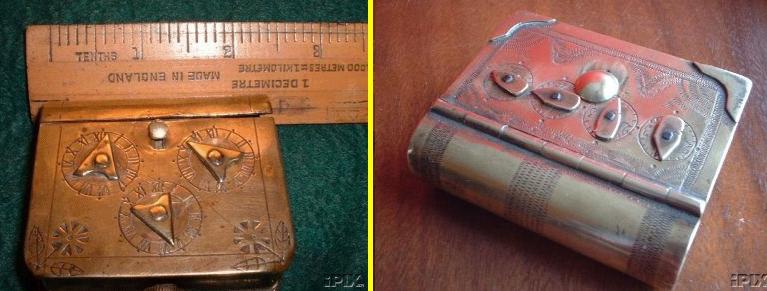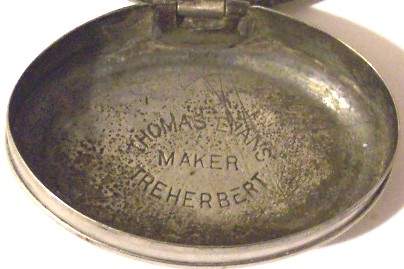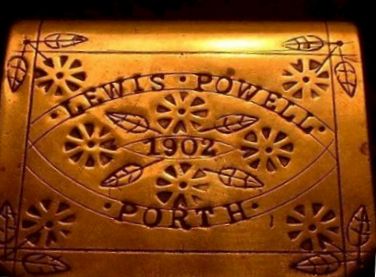
Surprisingly,
although mentioned in the list of commonly collected types of mining memorabilia
on the NMMA’s website, there has been nothing written to date regarding either
miner’s tobacco tins or snuff boxes.
Having resided in Wales for some 20 years, these items are regarded there as being fairly commonplace – or at least they were, until collector’s fever became all pervasive and they became more difficult to find. Now, having moved away from Wales, I find they are pretty much impossible to find in my new home of Nottinghamshire except for two examples I saw recently, one at an antique shop, the other at an auction, and even then they were both Welsh (Ynyshir and Abertillery). In fact I have only ever seen one that was not Welsh, and that was marked traditionally with the owner’s name, a date plus the place name – BRISTOL. Presumably this example emanated, like a few others I have recently heard of, from the South Gloucestershire and Somerset Coalfield.

A typical Welsh miners' tobacco or snuff tin bearing its original owners name and address - "A. E. BOON / 10 PRESTON ST. / ABERTILLERY". Original is of brass and measures approximately 3 inches long and has a hinged lid (see insert for typical opening details).
I
must say that I am fairly convinced that the majority of these tins belonged to
miners. Most of the place names are colliery related, and the addresses –
where they are marked – confirm this. However, I have seen one with the place
name RADYR, which was a large coal siding junction outside Cardiff. The nearest
collieries to this location (Rockwood Colliery and Nantgarw) were some three
miles away near Taffs Well, though that would not necessarily preclude daily
travel. On the other hand, there must have been a large number of manual workers
not colliery related who used these tins. I am told that some agricultural
workers used them also when they were not allowed to smoke during the corn
harvests.
Now, for what purpose were these tins really used? From their general appearance and size (typically oval of 75 mm by 45 mm by 20 mm deep) plus method of manufacture, they could not really be used for snuff. They are too big, subject to splitting at the hinge, and liable to fall open after rough usage. The only other item they could conceivably been designed to hold was “Twist” chewing tobacco – being topped up daily from a larger brass storage tin kept in their owners’ homes.
A typical storage tin similar to many of those used in the homes of late C19th Welsh miners for storing "Twist" tobacco. This brass example measures approximately 6 inches tall by 2.5 inches diameter.
Some of the tobacco tins that I have seen have not been cleaned inside and still retain the dark tobacco deposit, and smell sweetly pungent. So what about snuff? This was certainly used by the Welsh miners - but to what extent I am uncertain. I was informed also that snuff was sold in small tins, and was used thus, as to a limited extent it is today. There was therefore no need for any purpose-made snuff tin. I understand that miners in the northern areas took snuff extensively, and that chewing tobacco was kept in trouser or jacket pockets. I assume that both were purchased in a similar manner. But why should chewing tobacco tins appear to be confined to South Wales and Somerset?
The obverse and reverse sides of a highly engraved 3 inch long brass tobacco tin. The obverse bears the name of the tin's once owner "DAVID WATKINS" plus the date "1890".
In appearance the tobacco tins are usually oval, with some rectangular with rounded edges. They are made commonly of brass, of varying quality of construction from thin to quite substantive. The thin type dents and cracks easily, and there is almost invariably damage around the hinge to most of the brass tins with subsequent repair by soldering. This is a good area to examine for coal/oil deposits to confirm mining use. The best quality – and scarce - tins were made of nickel, and have better endured the years of use. A further type of extremely ornate and well-crafted brass tin exists which have complex locking mechanisms in place of their simple and usual tightly fastening lids. Two such rectangular tin examples I have seen can only be opened once the hands on various (three or four) clock dials have been correctly positioned. At least one of these examples also has a “dummy” spring-loaded opening button. If pressed down this unsuspecting brass button retracts allowing a steel pin to project out of its centre into the finger or thumb of the uninitiated!

Two "fanncy" tobacco tins - Both have combination number locks and are elaborately engraved on all sides. Both are rectangular and 2.5 and 3 inches tall respectively. The three number combination lock examples bears the name of "LEWIS POWELL" of "PORTH" plus the date "1902". The second, four number combination lock example, has been styled in the form of a book. It carries a personal name plus the location name "TREHARRIS" on its reverse side.
Most of the more collectable surviving tins are punched (often quite crudely) with the miner’s name, year, and place of residence. The years that I have seen have been between 1890 and 1928, but I am sure there are earlier ones and of course many later ones continuing to the closure of the collieries. Some have the miner’s full address – which is reflected in the purchase price today! Again, most have punched designs and patterns, many quite intricate. On some, the curved baseline guide marks made with a metal scriber can still be seen and on others the lines form part of the design. More rarely, with good quality tins the name of the manufacturer is also stamped inside the base of the tin. These manufacturers sometimes appear in commercial directories of the period listed as ironmongers, though they were not the only people to have made them. I am told that some boxes were even made in colliery lamp rooms while others custom made by local tinsmiths. As to their original selling prices I have no idea. It is further interesting to note that some boxes appear to have been made pre-patterned, ready to have their ultimate owner’s details added in a final customisation stage.

A scarce example of a tobacco tin bearing makers details on the inside of its bowl. In this case the maker is clearly stated as being one "THOMAS EVANS" of Treherbert, South Wales.
As with all collectibles in today’s markets the condition of antique tobacco tins greatly contributes to their value. However, one of the tins in my collection has a broken fastening mechanism showing heavy coal/oil deposits in and around the hinge space – suggesting that the tin had been used thus for some considerable time. Despite this damage the tin can be closed quite securely. I suppose this should be a case of prolonged original use having less value… but not much less by present prices!

The reverse side of the three digit combination lock tin shown above clearly displaying its date of manufacture plus the name and address of its once owner.
As with all artifacts that are increasing in value, there is the possibility of faking. Plain tins are sold as souvenirs in most mining museum shops and with the necessary effort and tools etc. could be made to appear old, certainly on a cursory inspection. So my advice to other collectors would always be “buyers beware”.
The obverse and reverse sides of a 2.75 inch long decorated brass tobacco tin. The obverse bears the name of the tin's once owner "EDWARD EVANS" below which appears to be the obliterated and miss spelt word "MINRE" (i.e. MINER). Also apparent is the owner's place of abode, "HENGOED" plus the date of the tin's manufacture (?) which in this case is "1910".
I am sure that readers will welcome further information on these tins, particularly regarding their presence in areas other than South Wales, and I look forward to reading more on the subject via the “Forum Page” of the NMMA’s website.
Acknowledgements
I make grateful acknowledgement to Garry Mason and Lyn Gladwin of South Wales for information and illustrations used in this article. I would also like to acknowledge Phil Baird and Mike Shaw of Bristol for confirming the use of “Welsh” style tobacco tins in the South Gloucestershire and Somerset Coalfield.
Based on an article in NMMA Newsletter No.29, Winter 2002. © David Shaw.